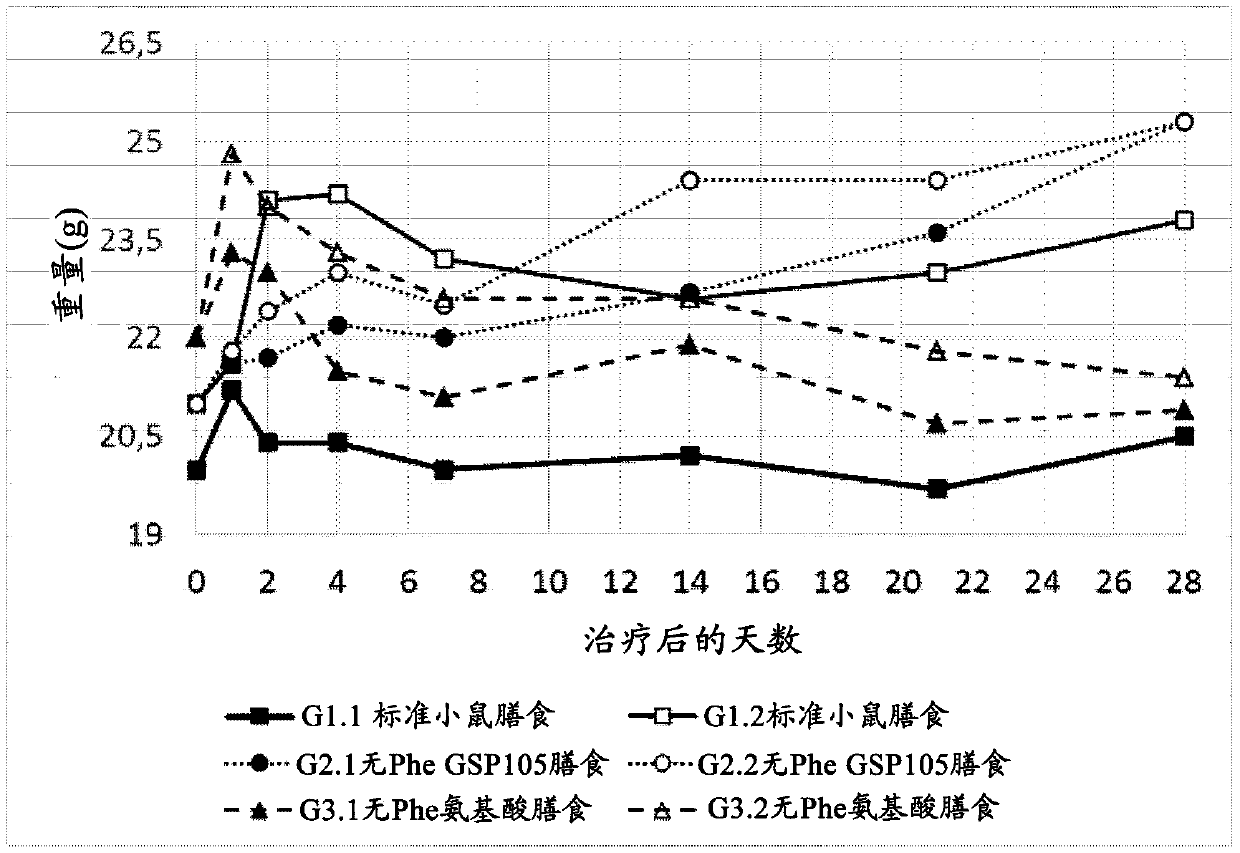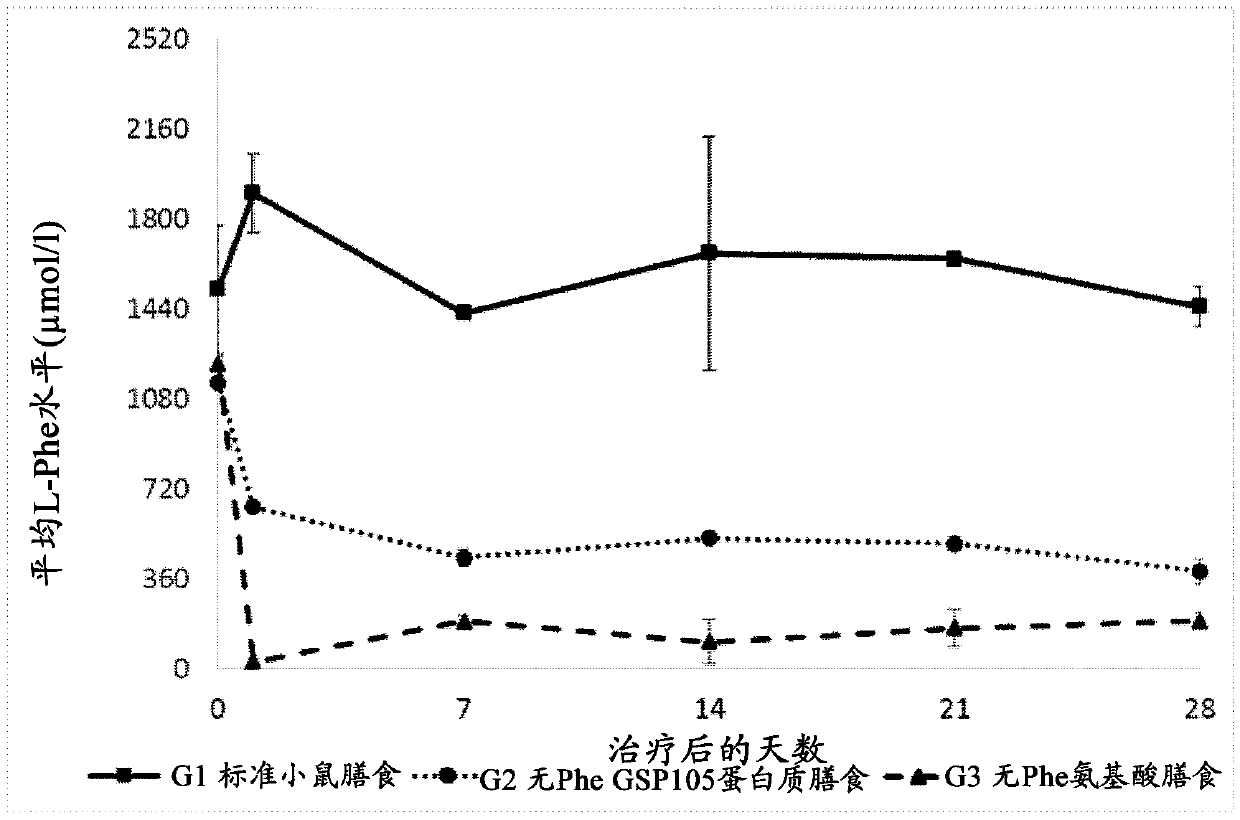Phenylalanine-free protein for treatment of pku
一种苯丙氨酸、蛋白质的技术,应用在肽/蛋白质成分、含蛋白质食品配料、抵抗媒介传播的疾病等方向,能够解决蛋白质不再被表达、改变蛋白质结构等问题
- Summary
- Abstract
- Description
- Claims
- Application Information
AI Technical Summary
Problems solved by technology
Method used
Image
Examples
Embodiment 1
[0063] Example 1 - Candidate Gene Discovery
[0064] To identify potential protein candidates meeting the required criteria for phenylalanine-free nutritional proteins, a self-designed search algorithm was used. Protein sequences from each genus or species were obtained from the UniProt database (http: / / www.uniprot.org) using the import feature of CLC MainWorkbench 6.6.1.
[0065] The proteins used are derived from common sources of food, such as vegetables (e.g. potatoes), but also from microorganisms (e.g. yeast) or animals (e.g. cattle). The Latin or common name of the species / genus (depending on which name resulted in a greater number of hits) was used as the search string. Downloading all hits except uncharacterized proteins yielded a total of 836,037 sequences from different species. The following search strings were used to identify the hits listed in Table 2.
[0066] Lists of amino acids present in each of the 836,037 genes were further generated using the "Creat...
Embodiment 2
[0079] Example 2 - Preparation of Bacillus subtilis
[0080] The synthetic gene GSP105 with the nucleotide sequence shown in SEQ ID NO 7 was inserted into the Bacillus subtilis expression vector pHT43 (MoBiTec, Germany), the recombinant protein was enabled to be secreted into the medium and introduced into protease-deficient Bacillus subtilis strain WB800N (MoBiTec), following the manufacturer's instructions.
[0081] After transformation, positive clones were selected on antibiotic selection plates; the presence of the expression vector was further confirmed by PCR, plasmid extraction and subsequent DNA sequencing. Glycerol stock cultures were generated and stored at -80°C.
[0082] A starter culture of recombinant Bacillus subtilis GSP105 was prepared as follows: 1 L of TB medium (Carl Roth, Karlsruhe, Germany) supplemented with chloramphenicol (Carl Roth) and neomycin (Carl Roth) was inoculated, and each final The concentration was 5 μg / ml and 1 ml of Bacillus subtilis...
Embodiment 3
[0087] Example 3 - Mouse Feeding Study (Pilot Study)
[0088] Research design:
[0089] Six adult, male, homozygous PKU mice (Pah enu2 / 2 ; Shedlovsky et al., Genetics 1993, 134:1205; http: / / www.pahdb.mcgill.ca / ? Topic=Information&Section=Mouse&Page=1) were divided into 3 groups with 2 mice in each group. Animals belonging to the same group share a single cage. These groups were fed as listed in Table 4. The main differences between the diets were protein composition and Phe content, as shown in Table 5. PKU mice were fed a standard mouse diet prior to the feeding study. The feeding study lasted 28 days, during which time the animals were given food and water ad libitum.
[0090] Table 4: Animal groups and animal diets (N=6)
[0091]
[0092] Table 5: Animal diets
[0093]
[0094]
[0095] "Phe-free GSP105 protein diet" or "Phe-free GSP105 diet" refers to a diet in which the only source of amino acids is recombinant dietary protein GSP105 supplemented with 0...
PUM
 Login to View More
Login to View More Abstract
Description
Claims
Application Information
 Login to View More
Login to View More - R&D
- Intellectual Property
- Life Sciences
- Materials
- Tech Scout
- Unparalleled Data Quality
- Higher Quality Content
- 60% Fewer Hallucinations
Browse by: Latest US Patents, China's latest patents, Technical Efficacy Thesaurus, Application Domain, Technology Topic, Popular Technical Reports.
© 2025 PatSnap. All rights reserved.Legal|Privacy policy|Modern Slavery Act Transparency Statement|Sitemap|About US| Contact US: help@patsnap.com



